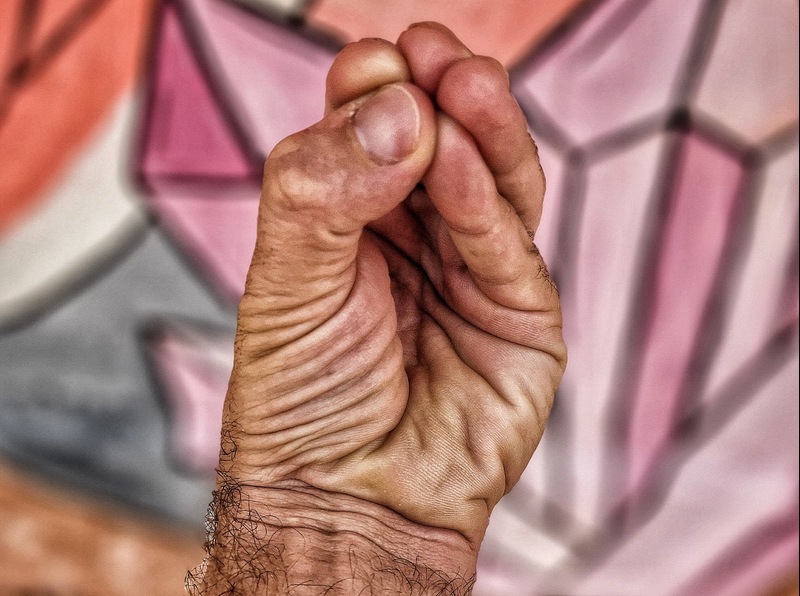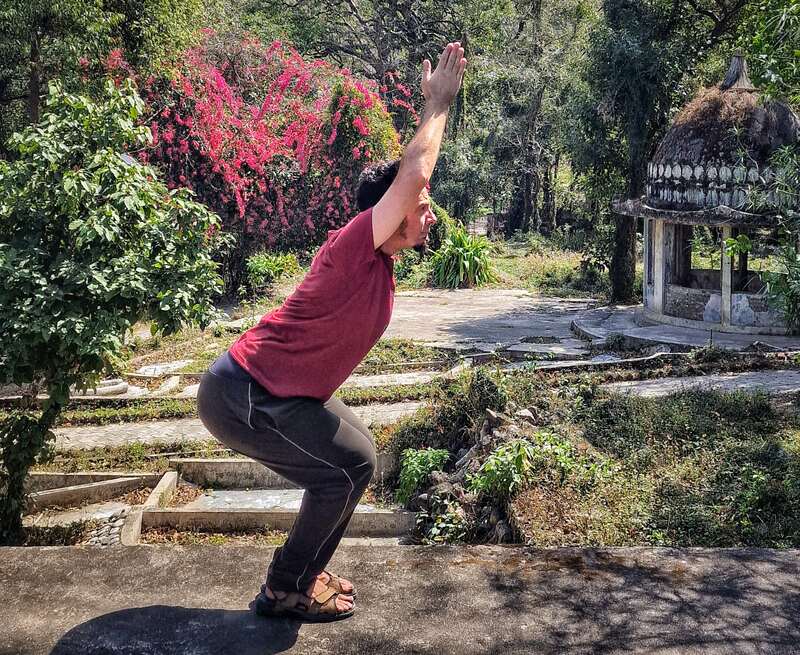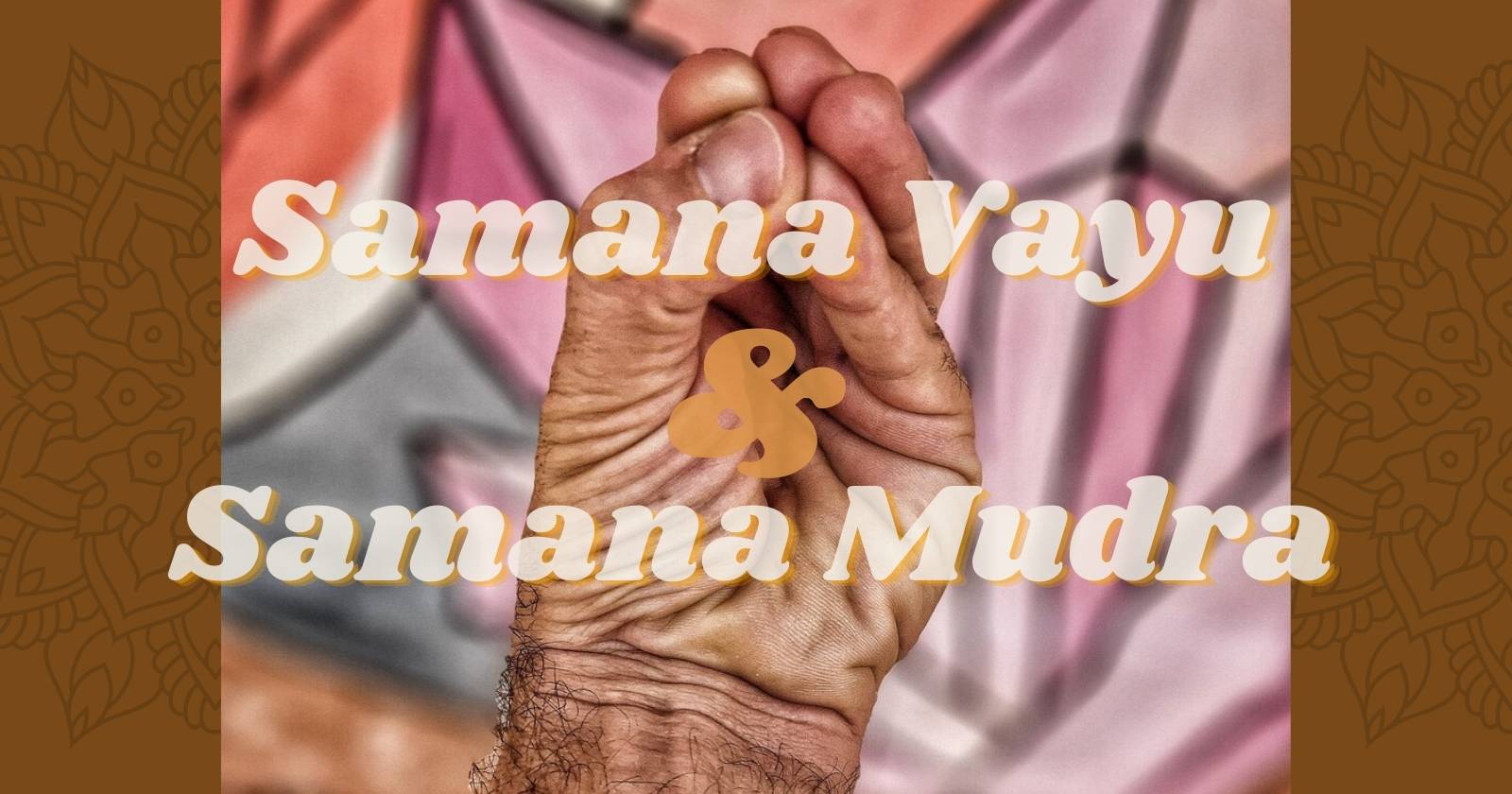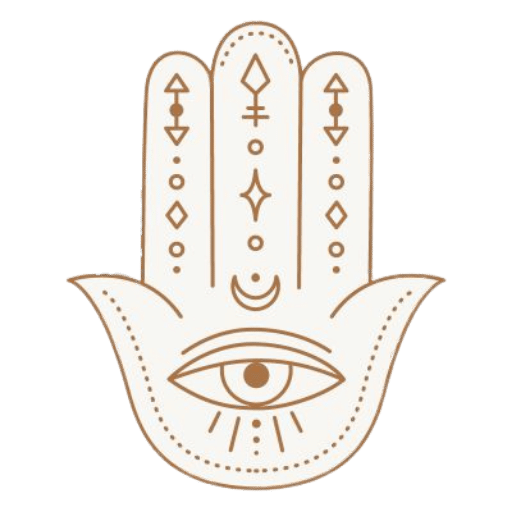
Unlock 5 transformative benefits of Samana Mudra. How to use Yoga to balance your Samana Vayu through Mudra, Asana, and Pranayama
In the world of yoga and Ayurveda, the human body is believed to be a vessel of energy, with subtle channels called “nadis” that carry the life force, known as “prana.” Among the five primary Vayus or vital airs, Samana (समान) Vayu holds a significant role in maintaining harmony and balance within the body. Combined with the practice of its special hand gesture, Samana Mudra, it becomes a potent force in improving overall well-being.
What is Samana Vayu?
Samana Vayu, one of the five Vayus, control’s the movement and flow of prana in the body. It resides in the region of the abdomen and is responsible for the assimilation and distribution of nutrients derived from the food we eat. It ensures that the energy of the food is evenly distributed throughout the body, nourishing every cell and tissue. This Vayu is closely linked to the digestive system and plays a vital role in the transformation of food into energy.
How to Do Samana Vayu Mudra

This Mudra primarily targets the Manipura Chakra (Solar Plexus), aiming to balance the air element and improve digestion, absorption, and assimilation.
To perform the Samana Vayu Mudra:
- Find a comfortable pose, such as a cross-legged posture used in pranayama or meditation. You may also use this mudra while lying down.
- Close your eyes, take a few deep breaths, and relax.
- Place your hands on your knees with palms facing upwards.
- Bring the tips of all your fingers to gently touch the tip of the thumb. (Keep your hand relaxed throughout the practice.)
- Remain in this position for 15 to 30 minutes at your convenience.
Maintain your awareness of the energy flow in the body. Feel the changes that the mudra brings about in your system.
The significance of the fingers in Samana Vayu Mudra
Mudras act as a bridge to connect the different Vayus within the body, including Samana Vayu. Each finger in the hand represents an element – thumb for fire, index finger for air, middle finger for space, ring finger for earth, and little finger for water. When we touch different fingers in specific ways, the elements combine, activating specific energy pathways and balancing the flow of prana.
Benefits of Practising Samana Vayu Mudra
Improved Digestion: Certain Mudras can aid digestion by stimulating Samana Vayu, promoting the efficient breakdown and absorption of nutrients.
Enhanced Mental Clarity: Activating Samana Vayu through Mudras can bring mental clarity and focus, improving cognitive abilities.
Improved liver function: With long-term use, it can strengthen the liver.
Lower Blood Pressure: Activating Samana Vayu can help with hypertension.
Balance Energies: It balances the body energies and the Tri-Doshas: Vata, Pitta and Kapha.
Contraindications of Samana Vayu Mudra
It’s important to be aware of situations when practicing Samana Vayu Mudra is not recommended. Avoid this mudra under the following circumstances:
- Injury and Surgery: Students with injuries to the palms, wrists, and fingers need to avoid this mudra. Students with recent wrist, finger, or palm surgery should not practice it.
- Illness or Weak Body: Students experiencing high blood pressure or cardiovascular issues, colds, fever, or flues should avoid it. This is because this mudra is believed to increase the Agni or digestive fire in the body, which can cause a rise in body temperature and blood pressure, exacerbating existing health conditions.
- Pregnant women should refrain from practicing Samana Vayu Mudra, particularly during the first trimester, as it applies pressure to certain acupressure points that may potentially induce uterine contractions.
Samana Vayu and Yoga Postures
Samana Vayu is a mudra best practiced while sitting in a cross-legged position on the floor. However, there are a number of yoga postures that can help Samana Vayu in general. Let’s look at a couple.
Parivritta Parshvakonasana (Revolving Side Angle Pose)

Incorporating Parivritta Parsvakonasana into your practice helps cleanse and nourish the abdominal organs while fostering energy balance in the pelvis and lower spine.
Step 1: Begin by standing with your feet hip-width apart. Take a step back with your left foot, positioning it about three to four feet behind the right foot.
Step 2: Bend your right knee and place both hands on your right thigh. Use your hands to assist in twisting your upper body to the right.
Step 3: As you twist, focus on keeping your spine long and straight. Adjust your stance if necessary to ensure that your left foot remains flat on the floor.
Step 4: Press your left upper arm or armpit against your right thigh. This action helps stack the shoulders and allows you to press your hands together. As a result, the left ribs lift away from your leg, creating space for the twist in your abdomen.
Step 5: Direct your attention to the gut area, where you should feel a deep squeezing and wringing out of the organs in your abdomen. This twisting action provides a strong cleansing and nourishing effect on the organs.
If you feel excessive tension in the muscles of your hip and pelvis, consider taking a gentler twist by slightly backing off. The goal is to localise the work in the navel centre, ensuring an effective twist without strain.
Shalabasana (Locust Pose)

This pose offers an invigorating backbend that strengthens the back muscles, improves posture, and stimulates the abdominal organs.
Step 1: Lie face down on the floor with your arms extended either alongside your head or alongside your body, depending on any shoulder issues you may have. Bring your legs together and stretch them out through your feet. Press your pelvis firmly into the floor.
Step 2: As you inhale, lift your legs, chest, and arms off the floor. Keep your focus on the navel centre as you press into the floor. Maintain a strong connection between the arms and legs, moving them towards the central axis of your body while simultaneously stretching away from the navel centre in both directions.
Step 3: Hold this lifted position for several breaths, allowing the energy to build and fill your body.
Step 4: Upon exhaling, gently lower your body back down to the floor, releasing the lift and relaxing your muscles.
Utkatasana (Chair Pose)

In the next phase, we will explore the subtler aspect of energy flow during Utkatasana, guiding the flow of apana and prana vayus towards the navel centre.
Step 1: Begin by positioning your feet parallel to each other, either keeping them together or a few inches apart.
Step 2: Gently bend your knees and lower your body weight into your feet while simultaneously stretching upwards through your arms, the crown of your head, and the entire length of your spine.
Step 3: Ensure that you evenly press your feet into the floor and away from each other. Additionally, send your tailbone toward the floor to maintain a neutral alignment in your lumbar spine, neither arched nor flattened.
Step 4: Draw your upper arms towards the sides of your head, keeping your shoulders relaxed and your elbows straight. Broaden your collarbones and lengthen your neck.
Step 5: Allow the outer body to drop, finding a working balance between the forward lean to balance the deep squat and the upward lift of the torso to resist the forward lean.
You can read more about these postures and their contraindications in the book Asana, Pranayama, Mudra and Bandha by Satyananda Saraswati.
Caution Note: Remember to listen to your body, honour its limitations, and seek guidance from a qualified yoga instructor if needed. Yoga teachers can provide appropriate modifications and alternatives to ensure a safe and beneficial practice tailored to your needs.
Conclusion and Integration of Samana Vayu into Daily Life
In conclusion, Samana Vayu plays a vital role in our overall well-being, both on the physical and energetic levels. By harmonising the flow of prana in the body and directing it towards the navel centre, this vital air enhances digestion, assimilation, and mental clarity. Incorporating Mudra practices further amplifies the benefits, leading to improved physical health, better mental focus, and a balanced energy flow.
Also check out :
>Apana Vayu Mudra: What Is It and How Do I Practice It?



